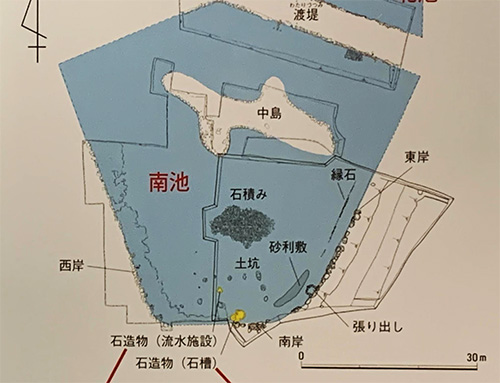

北海道で古代の様子を探ろう、人間痕跡を探ろうとすると
文字記録というのは日本書紀・阿倍比羅夫の条くらいなので、
必然的に考古発掘という動かしがたいモノの物証性から探ることになる。
そこから推論を重ねてその推論を証立てるモノを繋げていく。
北海道ではそういった考古資料の発掘が中心で「歴史」を掘り起こしていく。
そういった常識的世界にいるわけですが、
一方、本州以南地域では文献資料が基本で歴史を探索していくことになる。
魏志倭人伝のようななぞ解きのような世界が広がっている。
羨ましい反面、実証性に乏しいのではないかと疑問も感じ続けていた。
そんななかで文字記録が乏しい時代、飛鳥時代、飛鳥板蓋宮の時代は
これまで「ナゾの時代」とされてきている。
けれど、近年活発な考古発掘手法での解明が進んできている。
歴史・人間活動と建築、というわたしのライフワークとしては
非常に興味深い対象だと思い続けてきている次第。
しかし、北海道から飛鳥は遠隔すぎる(泣)。ときどきの機会を捉えて
実地探訪するのにも、事前に探索してから行くことになる。
NHKで飛鳥の都の「苑池」遺跡発掘の様子の番組があって
その現地確認と考古発見の実物を見学したいと思っておりました。
苑池というのは権力の中心都城を都市計画するときに
欠くことの出来ない「水道」技術と近縁する都市景観の装置。
その発掘調査の物証が橿原考古博物館で展示されている


都城は飛鳥板蓋宮であり、聖徳太子が活躍されたり
大化の改新とわたしの年代は教わった「乙巳の変」の舞台になった王宮。
都城からは木簡なども大量に出土するので政権としての官僚機構も
その痕跡を確認することができる。
最初期の日本の王権の姿が徐々に姿を現してきているということですね。
で、そういう都城では区画された「条坊制」都市に対して
水道が通されていた状況も明らかになってきている。
そしてその都城に随伴するように苑池が造営されたのだという。
上の写真はその苑池の南側池で発見された「水路装置」。
画面右側上部に傾斜の付いた丸い空洞部があるが、こうした石造物を連結させて
この空洞部をつないで水路として機能させていたというのです。
また、このような石造物の発展形として「噴水」装置までもあったとされる。
古代王権にとってその統治の「正統性」根拠を考えると
コメの民である日本民族としては「水源管理」がきわめて重要なのは自明。
水田土木建築、都市建設の主要な技術基盤が正統性の根拠だと推測できる。
そういう技術優位性を誇示するのに、このような苑池造営はされたのか。
この苑池では水位管理が行われ、地下伏流水と平行河川水の両方を
コントロールする技術が展開されていたという説が強い。
古代における最先端的技術追求の実物証明のように思えた次第。
古代都城のリアリティが俄然、明瞭に伝わってくる。
English version⬇
[Nara / Asuka Search-1 Traces of the Kingship of “Controlling Water”]
Aqueduct construction technology for paddy field construction is indispensable for rice society. It is highly possible that the legitimacy of the Japanese kingship was in the technology that governs food productivity.・ ・ ・
Let’s explore the ancient state in Hokkaido, when trying to explore human traces
Character records are about Nihon Shoki and Abe no Hirafujo, so
Inevitably, it will be explored from the physical evidence of archaeological excavation, which is difficult to move.
From there, we repeat inferences and connect things that prove the inferences.
In Hokkaido, the excavation of such archaeological materials is the main focus, and “history” is dug up.
I’m in that common sense world,
On the other hand, in the area south of Honshu, history will be explored based on literature materials.
A world like a mystery solver like the Wei Shi Yajinden is spreading.
On the other hand, I was envious of it, but I continued to wonder if it was not demonstrable.
Under such circumstances, the times when character records were scarce, the Asuka period, and the Asuka Itabuki Palace period
Until now, it has been called the “era of mystery.”
However, in recent years, elucidation by active archaeological excavation methods has been progressing.
As my life work of history, human activity and architecture
I keep thinking that it is a very interesting subject.
However, Asuka is too far from Hokkaido (crying). Seize occasional opportunities
Even if you want to explore the actual site, you will have to explore it in advance.
There was a program on NHK about the excavation of the “Enike” ruins in Asuka’s capital.
I wanted to see the actual site confirmation and archaeological discovery.
The garden pond is when planning the city of Miyakonojo, the center of power.
A device for urban landscapes that is closely related to the indispensable “water supply” technology.
The evidence of the excavation is exhibited at the Kashihara Archaeological Museum.
Miyakonojo is Asuka Itabuki Palace, where Prince Shotoku plays an active role.
The royal palace that was the setting for the “Isshi Incident” that was taught during the Taika Reform and my age.
Since a large amount of wooden tablets are excavated from Miyakonojo, the bureaucracy as an administration is also
The trace can be confirmed.
It means that the appearance of the earliest Japanese kingship is gradually appearing.
So, in such a city castle, for the divided “jobo system” city
It is becoming clear that the water was running.
And it is said that the garden pond was built to accompany the city castle.
The photo above is the “waterway device” found in the pond on the south side of the garden pond.
There is a round hollow with a slope at the top right of the screen, but by connecting these stone structures
It is said that this cavity was connected to function as a waterway.
It is also said that there was even a “fountain” device as a development of such a stone structure.
Given the “legitimacy” grounds of its rule for the ancient kingship
It is self-evident that “water source management” is extremely important for the Japanese people, who are the people of rice.
It can be inferred that the main technological foundations of paddy civil engineering and urban construction are the grounds for legitimacy.
Was such a garden pond built to show off such technological superiority?
Water level management is carried out in this garden pond, and both underground underground water and parallel river water are used.
There is a strong theory that control technology was being developed.
As soon as it seemed like a real proof of the pursuit of cutting-edge technology in ancient times.
The reality of the ancient city castle is clearly transmitted.
Posted on 4月 16th, 2022 by 三木 奎吾
Filed under: 住宅マーケティング, 歴史探訪







コメントを投稿
「※誹謗中傷や、悪意のある書き込み、営利目的などのコメントを防ぐために、投稿された全てのコメントは一時的に保留されますのでご了承ください。」
You must be logged in to post a comment.